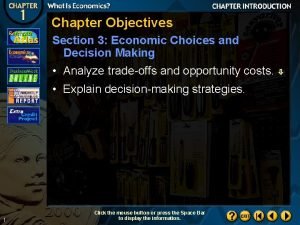Economic Decision Making Chapter 2 Essential Question Why





- Slides: 5

Economic Decision Making Chapter 2 Essential Question: Why can’t you always get what you want?

Wants and resources • Wants are unlimited, resources are limited. Scarcity results. • Goods – physical items (like shoes, bread, phone) are scarce • Services – activities done for us (like a mechanic fixing your car, someone mowing your lawn) are scarce • They are scarce because the resources to produce them are scarce (think leather-shoes, wheat-bread, plastic/glass/metal-phone, or labor for services) • Shortages – less of a good or service is available than people want at a set price. • Can be sudden (a fad or disaster). • But, shortages are temporary. • Scarcity, however, lasts forever.

Factors of production • 4 factors of production – productive resources/things used to make or do something 1. Land – “gifts of nature” 2. Labor – work, skill, knowledge 3. Capital – tools, machines, buildings, $? 4. Entrepreneurship – person who has idea, invests, takes risk, reaps reward or suffers loss • Together, these make goods and services • Productivity = output / input • Output is goods or service; input is a factor of prod.

2 ½ key terms • Opportunity cost – what we give up when we make a decision • Guns or butter? • Marginal utility – what’s gained by adding one more unit • Law of diminishing marginal utility – by adding one more unit, our gain gets smaller each time • Think eating slices of pizza • Graph is a hump • Optimum is the top of the hump

PPF • Production Possibilities Frontier – graph showing how an economy might produce 2 goods • We operate along the curve, ideally • Outside the curve is impossible • Inside the curve is inefficient (we can do better) • It’s used to measure opportunity cost
 Chapter 2 economic systems and decision making answer key
Chapter 2 economic systems and decision making answer key Chapter 2 economic systems and decision making
Chapter 2 economic systems and decision making Chapter 2 economic systems and decision making answer key
Chapter 2 economic systems and decision making answer key Chapter 1 section 3 economic choices and decision making
Chapter 1 section 3 economic choices and decision making Objectives of decision making
Objectives of decision making Investment decision financing decision dividend decision
Investment decision financing decision dividend decision









